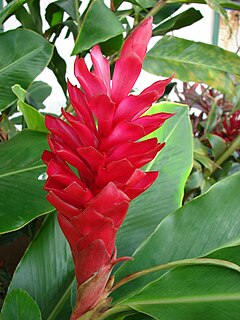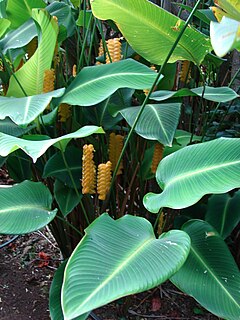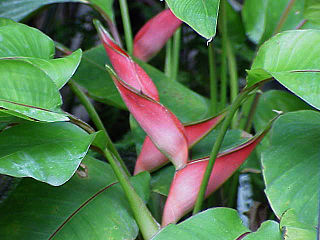
The Zingiberales are flowering plants forming one of four orders in the commelinids clade of monocots, together with its sister order, Commelinales. The order includes 68 genera and 2,600 species. Zingiberales are a unique though morphologically diverse order that has been widely recognised as such over a long period of time. They are usually large herbaceous plants with rhizomatous root systems and lacking an aerial stem except when flowering. Flowers are usually large and showy, and the stamens are often modified (staminodes) to also form colourful petal-like structures that attract pollinators.

The Bromeliaceae is a family of monocot flowering plants of 75 genera and around 3590 known species native mainly to the tropical Americas, with several species found in the American subtropics and one in tropical west Africa, Pitcairnia feliciana.

Pitcher plants are several different carnivorous plants which have modified leaves known as pitfall traps—a prey-trapping mechanism featuring a deep cavity filled with digestive liquid. The traps of what are considered to be "true" pitcher plants are formed by specialized leaves. The plants attract and drown their prey with nectar.

Heliconia, derived from the Greek word Ἑλικώνιος, is a genus of flowering plants in the monotypic family Heliconiaceae. Most of the ca 194 known species are native to the tropical Americas, but a few are indigenous to certain islands of the western Pacific and Maluku. Many species of Heliconia are found in the tropical forests of these regions. Most species are listed as either vulnerable or data deficient by the IUCN Red List of threatened species. Several species are widely cultivated as ornamentals, and a few are naturalized in Florida, Gambia, and Thailand. Common names for the genus include lobster-claws, toucan beak, wild plantain, or false bird-of-paradise. The last term refers to their close similarity to the bird-of-paradise flowers (Strelitzia). Collectively, these plants are also simply referred to as "heliconias".

Catopsis berteroniana, commonly known as the powdery strap airplant or the lantern of the forest, is an epiphytic bromeliad thought to be a possible carnivorous plant, similar to Brocchinia reducta, although the evidence is equivocal. Its native range is from southern Florida to southern Brazil. It generally grows on the unshaded twigs of trees, and has been shown experimentally to trap more insects in its tank than other bromeliads of comparable size. There are several other species in the genus, none of which is believed to be carnivorous.

Calathea is a genus of flowering plants belonging to the family Marantaceae. They are commonly called calatheas or prayer plants. About 200 species formerly assigned to Calathea are now in the genus Goeppertia. Calathea currently contains around 60 species. Native to the tropical Americas, many of the species are popular as pot plants due to their decorative leaves and, in some species, colorful inflorescences. The young leaves and bracts can retain pools of water called phytotelmata, that provide habitat for many invertebrates.

The Chironomidae comprise a family of nematoceran flies with a global distribution. They are closely related to the Ceratopogonidae, Simuliidae, and Thaumaleidae. Many species superficially resemble mosquitoes, but they lack the wing scales and elongated mouthparts of the Culicidae.

The harlequin poison frog, also known as harlequin poison-dart frog, is a species of poison dart frog endemic to the Chocó region of western Colombia. The frog is normally found on the ground of tropical rain forests, among fallen limbs or leaf litter. Some frogs traditionally classified as Oophaga histrionica were separated as new species in 2018. These are Oophaga anchicayensis, Oophaga andresi and Oophaga solanensis.

Heliconia stricta is a plant species native to Brazil, Colombia, Venezuela, Ecuador, Peru, Bolivia, Guyana, Suriname, reproducing by seeds and by underground rhizomes. It is reportedly naturalized in Cuba and Puerto Rico, and cultivated as an ornamental in many other warm regions. The young leaves and bracts retain water, forming pools called phytotelmata, which provide habitat for diverse invertebrates.

A protocarnivorous plant, according to some definitions, traps and kills insects or other animals but lacks the ability to either directly digest or absorb nutrients from its prey like a carnivorous plant. The morphological adaptations such as sticky trichomes or pitfall traps of protocarnivorous plants parallel the trap structures of confirmed carnivorous plants.

The Pseudostigmatidae are a family of tropical damselflies, known as helicopter damselflies, giant damselflies, or forest giants. The family includes the largest of all damselfly species. They specialize in preying on web-building spiders, and breed in phytotelmata, the small bodies of water held by plants such as bromeliads.
Chiasmocleis antenori, also known as the Ecuador silent frog, is a species of frog in the family Microhylidae. It is found in eastern Ecuador, eastern Peru, and western Brazil (Acre). It might be a species complex.

Carnivorous plants are plants that derive some or most of their nutrients from trapping and consuming animals or protozoans, typically insects and other arthropods. Carnivorous plants still generate some of their energy from photosynthesis. Carnivorous plants have adapted to grow in places where the soil is thin or poor in nutrients, especially nitrogen, such as acidic bogs. They can be found on all continents except Antarctica, as well as many Pacific islands. In 1875 Charles Darwin published Insectivorous Plants, the first treatise to recognize the significance of carnivory in plants, describing years of painstaking research.

Tillandsia utriculata, commonly known as the spreading airplant or the giant airplant, is a species of bromeliad that is native to Florida and Georgia in the United States, the Caribbean, southern and eastern Mexico, Central America, and Venezuela.

Parasyrphus nigritarsis is a species of hoverfly, from the family Syrphidae, in the order Diptera. It is known from northern Europe and North America, and has been considered to be a rare species in parts of its range. Adults visit flowers as a source of nutrition, and females lay their eggs on clutches of eggs of leaf beetles. When the Parasyrphus larvae hatch, they first consume leaf beetle eggs and then consume immature beetles until they reach the pupal stage. This species is related to hoverflies that prey on aphids as larvae, and has been investigated in studies of chemical ecology and food web ecology.
Excidobates captivus, the Santiago poison frog or Rio Santiago poison frog, is a species of frog in the family Dendrobatidae. It is endemic to northwestern Peru and southern Ecuador. Its natural habitat is tropical moist lowland forests. This frog is black with rows of orange-red spots on its back and yellow spots underneath.
Daphnephila truncicola is a species of gall midges first associated with stem galls on Lauraceae species, particularly Machilus thunbergii in Taiwan. Based on analysis on sequences of the mitochondrial cytochrome c oxidase subunit I, it has been suggested that in this genus, the stem-galling habit is a more ancestral state as opposed to the leaf-galling habit. This genus appears to have originated tropically and dispersed to Japan through Taiwan.
Phytotelmatrichis osopaddington is a species of beetle in the family Ptiliidae, or the featherwing beetles. It is only known from Peru. It is one of the top 10 new species named in 2015.
Walter John Emil Kress is an American botanist and the vice-president for science at the National Museum of Natural History. He currently holds the appointment (2010) as the Director of the Consortium for Understanding and Sustaining a Biodiverse Planet at the Smithsonian and is the former Executive Director of the Association for Tropical Biology and Conservation.

Bryocyclops is a genus of freshwater-dwelling cyclopoid copepods. The epithet Bryo- for Bryophyta (Mosses) refers to the fact that the first few species were described from mosses.
















